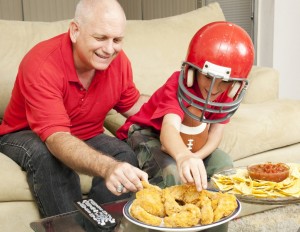 Americans are fat. More than two-thirds of adults in the U.S. are overweight or obese.
Americans are fat. More than two-thirds of adults in the U.S. are overweight or obese.
Big portions are a big reason. Drinks, snacks and meals have all gotten bigger over time. As portion sizes increase, people get fatter.
Our perceptions play a role. An experiment conducted at a Super Bowl party found that people who were served snacks from large (four-liter) bowls ate 56 percent more than people served from smaller (two-liter) bowls. The larger bowl made portions look smaller. If you don’t want your friends to overeat, use smaller bowls at your Super Bowl party.
The Small Plate Movement promotes using 10-inch plates instead of 12-inch plates. People eat 22 percent fewer calories from a smaller plate, without affecting their perceived fullness or satisfaction.
But the market doesn’t help reduce portion size. Starbucks offers its iced drinks in a gigantic 31-ounce cup size, the “Trenta.” The Trenta is bigger than the capacity of the average stomach. Twenty years ago, take-away coffee came in a seven-ounce cup.
Dan Ariely talked with National Public Radio about an experiment on portion sizes that he conducted at Panda Express, a Chinese fast-food restaurant. Ariely is a professor of psychology and behavioral economics at Duke University and author of The Upside of Irrationality.
When asked if they would accept a smaller portion of the main dish, most people said “No way.” Would they accept a smaller portion of fries, the side dish? “Sure.”
But after the study ended, people didn’t take the initiative to ask for a smaller serving of fries. Is it too much work? A break in the normal routine? Do they feel cheated? Or something else?
What can these studies tell us about how to change environmental behaviors?
1. Perception is reality. Visual cues tell us how to interpret the world. The environmentally friendly or socially preferable option should look appealing, familiar and not too complicated.
2. Think about what you offer. People may buy a larger pesticide container because it’s cheaper per ounce than the smaller one, even if they don’t need that much. Can we change the price signal for products that harm the environment?
3. Change the market. I followed sales data for hazardous cleaning products for a few years. One year the sales of less-toxic toilet bowl cleaner skyrocketed because a major manufacturer introduced a safer, greener brand. Can we encourage more of those changes?
4. Make it simple to do. A setback thermostat is easy to use and can dramatically reduce energy consumption. That’s simpler than asking people to remember to turn the temperature up and down in their home. Don’t make them do too much work.
Ed. note: In honor of my 10th anniversary in business, I am updating and reposting some of the posts from my (now-defunct) Sage Enviro blog to make it easier for people to find them.